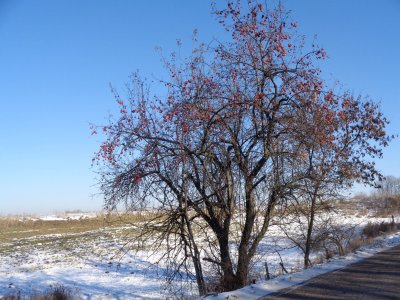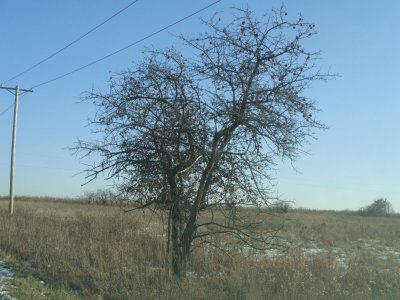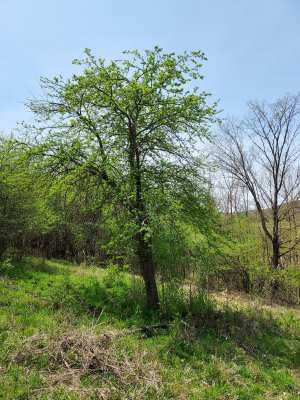-
If you are posting pictures, and they aren't posting in the correct orientation, please flush your browser cache and try again.
Edge
Safari/iOS
Chrome
You are using an out of date browser. It may not display this or other websites correctly.
You should upgrade or use an alternative browser.
You should upgrade or use an alternative browser.
Why do wild crab or larger wild apples predominate?
- Thread starter sandbur
- Start date
AtomApple
5 year old buck +
just a few ideas:
crab trees have 1000s of fruit vs 100s on an apple tree.
if crabs already out number apples in an area, you might be talking millions of fruit vs 100s.
birds eat the crabs, but not the apples, the crab seeds are smaller and can path through the digestive system and be spread easier
even a normal size apple might have 50% or more crab DNA in its seed.
summary : volume, distribution, genetics
crab trees have 1000s of fruit vs 100s on an apple tree.
if crabs already out number apples in an area, you might be talking millions of fruit vs 100s.
birds eat the crabs, but not the apples, the crab seeds are smaller and can path through the digestive system and be spread easier
even a normal size apple might have 50% or more crab DNA in its seed.
summary : volume, distribution, genetics
sandbur
5 year old buck +
just a few ideas:
crab trees have 1000s of fruit vs 100s on an apple tree.
if crabs already out number apples in an area, you might be talking millions of fruit vs 100s.
birds eat the crabs, but not the apples, the crab seeds are smaller and can path through the digestive system and be spread easier
even a normal size apple might have 50% or more crab DNA in its seed.
summary : volume, distribution, genetics
That leads me back to the pre settlement times when some areas had M. Ioensis and some didn’t. I bet a lot of the original, native genetics persist. Crab genetics.
Sent from my iPhone using Tapatalk
chickenlittle
5 year old buck +
I don’t think there’s much native crab genetics left out there. Lots of non-native crab genetics from flowering crabs, though.
Apple size is a distribution centered on what you’d call an apple crab. That is normal size. The large apples are the rare outliers from that seedling population. But those rare ones were selected and propagated. Even if you cross 2 large apples, most of the seedlings would produce what you’d call apple crabs. Skew that size smaller if the large apple was pollinated by flowering crabs.
Apple size is a distribution centered on what you’d call an apple crab. That is normal size. The large apples are the rare outliers from that seedling population. But those rare ones were selected and propagated. Even if you cross 2 large apples, most of the seedlings would produce what you’d call apple crabs. Skew that size smaller if the large apple was pollinated by flowering crabs.
My NW WI area tends to have wild full sized apples, which is the opposite of the wild crabapples I see in SE MN. I don't think there were any native wild crabapples in that area of NW WI, so it seems likely the initial settlers planted full sized apples for food and the apple/apple pollination made seedlings that were full sized apples. That's my theory any way. It is very easy to drive around and find old abandoned farm sites and most of them have an ancient apple tree or two still holding on. Lots of random ditch apple trees as well that are full sized.
In SE MN there are tons of wild crabapples, but wild full sized apples are rare. Some of the wild crabapples have desirable drop times and they are definitely worth keeping, but many are better for birds than deer.
In SE MN there are tons of wild crabapples, but wild full sized apples are rare. Some of the wild crabapples have desirable drop times and they are definitely worth keeping, but many are better for birds than deer.
b116757
5 year old buck +
My mothers place in NW Wisconsin has 20-30 wild apple trees on 80 acres a total of one of them is full sized and of decent quantity. We would get pickup loads of apples from the Bayfield orchards and used them as deer bait for many years we did this growing up. Fast forward 40 years and that’s where all the wild trees on that property came from we now have so many producing trees my family no long bother going to Bayfield to get them and I believe they have changed the baiting laws. I also planted a dozen or so cultivars in my mothers yard about 25 years ago and most of those trees produce well in addition to the wild trees spread all over the place.
4wanderingeyes
5 year old buck +
Do deer spread apple seeds? Or as it passes through them, does it destroy the seeds?
I wonder if some of it is that birds eat the crabs, and spread the seeds, but full sized apples birds cant eat as easily to spread the seeds. So do the apple seeds spread from bear and deer?
I wonder if some of it is that birds eat the crabs, and spread the seeds, but full sized apples birds cant eat as easily to spread the seeds. So do the apple seeds spread from bear and deer?
Bowsnbucks
5 year old buck +
Many of the "wild" crabs (or apples) in northern Pa. and also in N.Y. are "bushier" in appearance and have multiple trunks. Even some of the commercially-sold crabs for pollination and landscape use are bushier in their growth habits.Do crabs tend to have more of a ‘bushy’ type growth with closer limb structure?
I saw many wild, "abandoned" crab and apple trees/bushes in upstate N.Y. Overgrown fields and weed patches seem to have a good number of such crabs & apples growing in them In N.Y. Some have small 3/4" fruit, and others have 1" to 2" fruit on them. I stopped to taste a few while visiting the Finger Lakes wine region in several past falls, and some were pretty tasty. Some looked more like a lilac bush than a crab / apple "tree."
Bowsnbucks
5 year old buck +
Turkeys, grouse (partridge), foxes, coons, deer, bears all can eat and pass apple seeds. Whether those seeds are viable after going through their guts ....... I don't know. Probably some are. If deer and bears (especially) can pass whole kernels of corn, I'd think apple or crab seeds would pass easily.Do deer spread apple seeds? Or as it passes through them, does it destroy the seeds?
I wonder if some of it is that birds eat the crabs, and spread the seeds, but full sized apples birds cant eat as easily to spread the seeds. So do the apple seeds spread from bear and deer?
AtomApple
5 year old buck +
I know for a fact that tomato seeds can pass through a human digestive system and be viable.Turkeys, grouse (partridge), foxes, coons, deer, bears all can eat and pass apple seeds. Whether those seeds are viable after going through their guts ....... I don't know. Probably some are. If deer and bears (especially) can pass whole kernels of corn, I'd think apple or crab seeds would pass easily.
during a remodel this spring, we were without a toilet for a month at the cabin. This Fall, we walk past my “special tree” and there were a few tomato looking plants growing in the woods. We checked the foliage with a phone app, and “ sure as sh!t
probably TMI, bu5 oh well.
rocksnstumps
5 year old buck +
Tend to agree that likely more related to local gene pool and what the surrounding area has available. I see very few if any ornamental crabs or crabs in general when looking at the old home farm yards are/were located. Think they were more practical and planted full size apple trees and for the pretty stuff to look at it was mainly some type of flowers and lilac bushes. Lots of lilacs on old farmsteads around here and some have also escaped to the ditches.My NW WI area tends to have wild full sized apples, which is the opposite of the wild crabapples I see in SE MN. I don't think there were any native wild crabapples in that area of NW WI, so it seems likely the initial settlers planted full sized apples for food and the apple/apple pollination made seedlings that were full sized apples. That's my theory any way. It is very easy to drive around and find old abandoned farm sites and most of them have an ancient apple tree or two still holding on. Lots of random ditch apple trees as well that are full sized.
In SE MN there are tons of wild crabapples, but wild full sized apples are rare. Some of the wild crabapples have desirable drop times and they are definitely worth keeping, but many are better for birds than deer.
Out of a dozen roadside apples in a mile and a half stretch most are smaller but still average about 2-1/2 - 2-3/4" dia. Only one tree has crab size 1-1/2" fruit and they are also a different color being mostly yellow.
Some pics of trees within a short stretch that pretty much show being multi-trunked and kinda gnarly just like most crabapples, but hey never been pruned (except by wildlife)
This one is still holding a fair amount apples yet as of yesterday but not a consistent tree year after year for production.

Others have dropped more apple already but still cookie cutter in general form which probably makes the sunscald not really an issue on whether favoring crabs or apples.


Apple Junkie
5 year old buck +
At our camp in NY, smaller crabs predominate. But interestingly, I have noticed that the size of the tree corresponds to the size of the apple. There are no large crabapple trees, and no small trees that produce large apples.
On 90 acres, there are 8 large (25’) “wild” apple trees, all of which grow larger apples. One of these was planted by a previous owner close to the camp, but the other 7 are “volunteers” as they are widely dispersed in what once was a remote pasture area. In that same scrub area, there are far more of smaller (8’) wild apple trees that produce 1” green “crabapples”. The larger apple trees are finicky, producing every other year at best, while the crabapples produce a dependable crop every year. Also, the crabapples are all very similar to each other, while the larger apples vary in size and color from tree to tree.


On 90 acres, there are 8 large (25’) “wild” apple trees, all of which grow larger apples. One of these was planted by a previous owner close to the camp, but the other 7 are “volunteers” as they are widely dispersed in what once was a remote pasture area. In that same scrub area, there are far more of smaller (8’) wild apple trees that produce 1” green “crabapples”. The larger apple trees are finicky, producing every other year at best, while the crabapples produce a dependable crop every year. Also, the crabapples are all very similar to each other, while the larger apples vary in size and color from tree to tree.


Natty Bumppo
5 year old buck +
Do deer spread apple seeds? Or as it passes through them, does it destroy the seeds?
My college wildlife bio professor told us back in the 90's that wild apple seeds HAD TO pass through the gut of a deer before they germinated. That the stomach acid changed the seed chemically so that it would only germinate when a deer walked somewhere else and pooped out the seed in a little pile of fertilizer...thus reducing competition between the parent and its offspring.
I don't believe this is absolutely true though. But yes, apple seeds can survive the trip through a deer's stomach. Whether it's obligatory for germination I do not know.
sandbur
5 year old buck +
My college wildlife bio professor told us back in the 90's that wild apple seeds HAD TO pass through the gut of a deer before they germinated. That the stomach acid changed the seed chemically so that it would only germinate when a deer walked somewhere else and pooped out the seed in a little pile of fertilizer...thus reducing competition between the parent and its offspring.
I don't believe this is absolutely true though. But yes, apple seeds can survive the trip through a deer's stomach. Whether it's obligatory for germination I do not know.
I have years of proof and decades of proof from my wife’s grandma that apple seeds don’t need to pass through deer to germinate, at least in northern climates where we have winter.
Sent from my iPhone using Tapatalk
Natty Bumppo
5 year old buck +
I have years of proof and decades of proof from my wife’s grandma that apple seeds don’t need to pass through deer to germinate, at least in northern climates where we have winter.
Sent from my iPhone using Tapatalk
Yes, I do not believe this to be true...completely, though there might be some partial truth and maybe the science wasn't clearly understood. I can see how an apple seed in a pile of deer pellets might have an advantage and grow more vigorously in its own little pile of fertilizer.
Clearly a lot of guys here are growing apples from seed...so no deer required.
4wanderingeyes
5 year old buck +
I have never found any wild apple trees around my land, or have seen any near me. But it is big woods, so not many old farms around to spread them. But now between my neighbor and myself, the deer and other critters have many apple trees and apples to eat to spread seed. Hoping maybe we will start seeing some wild apple trees someday.
Bowsnbucks
5 year old buck +
They do like sunlight. We almost lost an OLD apple tree at camp that was surrounded and completely shaded by pines. We cut down some of those pines (mostly on the south/sunny side) to decrease competition and get sunlight on that tree. The first year after we released it, that old relic put on blossoms and produced fruit for the first time in years.
cavey
5 year old buck +
Yes, I do not believe this to be true...completely, though there might be some partial truth and maybe the science wasn't clearly understood. I can see how an apple seed in a pile of deer pellets might have an advantage and grow more vigorously in its own little pile of fertilizer.
Clearly a lot of guys here are growing apples from seed...so no deer required.
I think to a degree its even simpler than the deer poo theory, at least around here. We have a number of local orchards and historically every farm had an orchard or a few trees. Apples that drop on a farmstead - in the past anyways were raked up and tossed over the fence as a kind of livestock feed. Cows ate them and in the "back" end little cow pies in the pasture afforded a nice little fertile growing spot. Most of the wild apples and crabs you see around here are in old pastures. Its unfortunate but with the collapse of the family farms these trees will be lost over time and less and less common.
b116757
5 year old buck +
Very few folks planting fruit trees as compared to generations past almost all old farm stead’s had some fruit trees very few new homes get fruit trees planted in the yard.I think to a degree its even simpler than the deer poo theory, at least around here. We have a number of local orchards and historically every farm had an orchard or a few trees. Apples that drop on a farmstead - in the past anyways were raked up and tossed over the fence as a kind of livestock feed. Cows ate them and in the "back" end little cow pies in the pasture afforded a nice little fertile growing spot. Most of the wild apples and crabs you see around here are in old pastures. Its unfortunate but with the collapse of the family farms these trees will be lost over time and less and less common.
Similar threads
- Replies
- 16
- Views
- 3K
- Replies
- 123
- Views
- 11K
